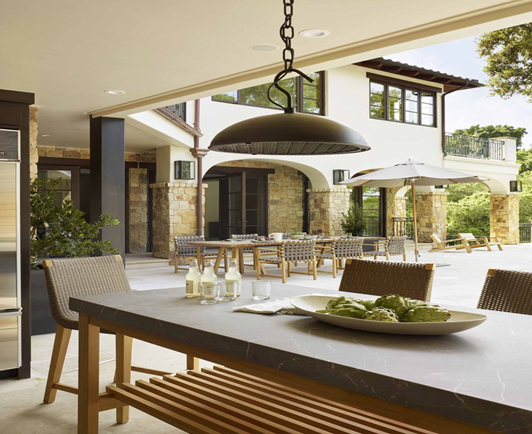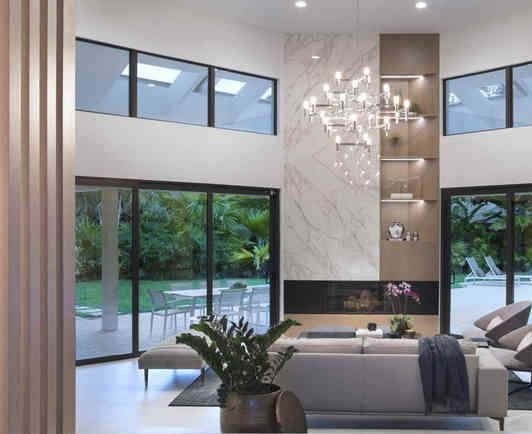Mediterranean-style homes, which resemble the aesthetic of Mediterranean villas, originated in the 1920s. During this period—the Roaring Twenties—people were consumed with wealth and leisure, resulting in the rise of seaside resorts in the United States.
A blend of Spanish and Italian architecture, Mediterranean homes are dominant in warm-weather locations like California and Florida, which also have Spanish influences. Popular architects at the time were Addison Mizner, who advanced this home style in Florida, along with Bertram Goodhue, Sumner Spaulding, and Paul Williams in California.
Alison Davin of Jute Home and DKOR Interiors' Ivonne Ronderos provided us with background on the common characteristics of Mediterranean houses and their top decorating tips to consider.
MAIN CHARACTERISTICS
A Mediterranean house is a dream for someone who appreciates simple, yet elegant, spaces. "It's timeless and quintessential California," says Jute Home's Alison Davin, who is based in California. "If you want a house that is not trending and won't require updating—one with really warm woods, bright walls, and indoor-outdoor living—it's never really going to go out of style."
The exterior of Mediterranean homes typically feature a red-tiled roof (usually terra cotta), as well as brick or stucco that’s often painted white. Stone details, carved doors, and raw iron and metalwork on windows, over balconies, and front doors are other common features.

There are three main styles of Mediterranean homes:
- Italian Renaissance: Drawing inspiration from buildings during the Italian Renaissance, this style is marked by columns and rounded arches.
- Spanish Revival: This home, which is influenced by Spanish colonial architecture, usually boasts simple, clean lines and a low-pitch roof.
- Modern Mediterranean: The style has traditional characteristics of Mediterranean homes with a modern twist. A focus on indoor-outdoor living, spacious, open floor plans, along with Spanish and Italian influences, are evident in these homes.
COMMON CHALLENGES
Living in a warm location comes with its own set of design challenges, especially for a Mediterranean-style property. "If you're on a big piece of land in a warmer climate, like California, and you paint the house white, the staining of wood doors and windows doesn’t wear very well because of the sun, so we're using a lot of metal right now," Davin says.
Plus, there’s the issue of inadequate light and storage. “A lot of times, we have to add windows and skylights, because Mediterranean homes tend to have smaller, more intimate spaces, lower ceilings, and smaller windows,” Davin says. “And in this style of home, you need more storage because there are no upper cabinets.”
According to Davin, achieving a cohesive look is also key. “Older Mediterranean homes were built really small and people add on to them haphazardly over the years,” she says. “We have to gut them to make sure they have a cohesive feel.”

DESIGN TIPS
When it comes to decorating a Mediterranean-style house, an understated look is best. Davin relies on the principle of symmetry to showcase the beauty of the style. "Because it is so pared down, we try to keep the decorating really symmetrical," she says. "We do pairs of chairs, pairs of sofas, pairs of sconces."
Painting the space in one color and opting for the same flooring type throughout the property can give it a unified look. Eye-catching tiles, both inside and outside, can inject personality as well. And for even more character, Davin incorporates archways. “We like to reframe a lot on the inside to make interior archways instead of rectangular archways,” Davin says. “We do a lot of 12-inch interior archways that are more substantial, as well as arched staircases and doors."
Considering the warm woods that often appear in a Mediterranean home, Davin finds that this style of property looks best with dark wood and walnut furniture, quirky, smaller-scale antiques, neutral lightweight fabrics like linen, and strategic pops of color, especially when it comes to tiles.
Outdoors, the goal should be to aim for a welcoming vibe. "We create intimate spaces—like a built-in fire pit that feels really cozy or a canopy over a dining area—so it feels more like a destination versus one big, expansive space," Davin says.



















Your Message